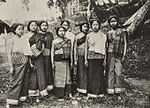Sinh (clothing)
From Wikipedia, the free encyclopedia

Laotian women wearing sinhs
The sinh (Lao: ສິ້ນ Lao pronunciation: [sȉn], Thai: ซิ่น Thai pronunciation: [sîn]) is a traditional garment worn by Lao and Thai women, particularly Northern Thai and Northeastern Thai women, in Laos and Thailand respectively. It is a tube skirt which can identify the woman who wears it in a variety of ways. In particular, it can indicate which region the wearer is from. In present day Thailand, sinhs are typically worn in special events. However, in Laos sinhs are worn more regularly in daily life.
Components

A typical Tai Yuan sinh.
A sinh is typically composed of three components:
- hua sinh (Lao: ຫົວສິ້ນ), literally "the head of the sinh", is the waistband part, which is typically tucked in and hidden.
- phuen sinh (Lao: ຜືນສິ້ນ) or tua sinh (Thai: ตัวซิ่น), literally "the body of the sinh", is the body part which is the main part of the sinh. This part of the sinh is typically not detailed. In particular, it typically only consists of one or two colors.
- tin sinh (Lao: ຕີນສິ້ນ), literally "the foot of the sinh", is the hem part. The hem is typically woven with a lot of details. The specific details of the hem can indicate where the sinh is made.
Textiles
The sinh is made of silk, woven in exquisite motifs as well as delicate embroidery. They come in different textures and designs and are usually created in rural areas by ethnic groups.
Bibliography
- Dolly Brittan (1997). The People of Laos. New York: PowerKids Press. ISBN 082-3951-24-3.
- Edeltraud Tagwerker (2009). Siho and Naga--Lao Textiles: Reflecting a People's Tradition and Change. Frankfurt am Main: Peter Lang. ISBN 363-1586-89-2.
Gallery
|
External links
See also
This article is issued from Wikipedia. The text is available under the Creative Commons Attribution/Share Alike; additional terms may apply for the media files.

